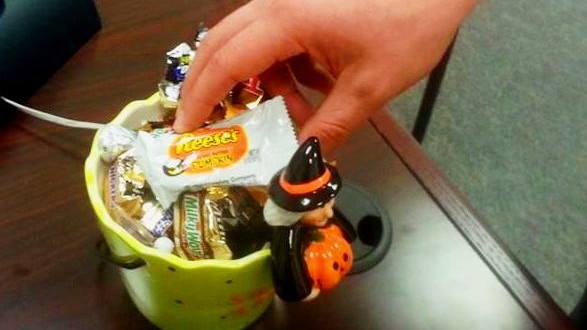
For many people, the scariest part of Halloween is not a visit from ghouls, ghosts and goblins, but the temptation of candy bars, caramel apples and candy corn that is everywhere. In fact, it is hard not to find a place during the Halloween season that does not have a bowl of those bite-sized tasty treats tempting us.
And let’s be honest: who can eat just one of those bite-sized Halloween candies? What is scary is that those two or three bite-sized candy bars will likely meet, if not exceed, the American Heart Association’s daily added sugar requirements of no more than 100 calories per day for women and no more than 150 calories per day for men.
Eat just those two bite-sized treats each day for the next three weeks leading up to Halloween and you will most likely gain a pound. That may not sound like much weight gain, but a recent review published in Physiology & Behavior found that most of us never lose that pound – and year after year this annual holiday weight gain can lead to health problems such as obesity, heart disease or Type II diabetes.
Overweight and obese adults tend to put on even more weight – around 5 pounds – over the holiday season. This same trend exists for children, with overweight kids putting on more weight during the holidays than normal-weight kids.
The scary truth is that most of us don’t exercise enough to warrant those extra Halloween calories. In fact, a sedentary lifestyle may be more to blame for the increased obesity in the United States than caloric intake. A recent study published in The American Journal of Medicine reveals that in the past 20 years there has been a sharp decrease in exercise, while caloric intake has remained steady.
In other words, declines in exercise may be responsible for the upward trend in obesity rates. So let’s get moving so those bite-size treats don’t play a nasty trick of our health.
ASK FIT LIFE
How do I know if my office is unhealthy?
Getting an office window may be good not only for your career, but also your health. Recent research published in the Journal of Clinical Sleep Medicine found that a good night’s sleep is related to where you sit all day at work. Employees who had window offices slept longer at night (a total of 46 minutes longer), were more active during the day and had better physical health and energy than their windowless colleagues.
Sleep experts have long known that exposure to light helps regulate your sleep-wake cycle, or circadian rhythm, and in turn puts you in a better mood and gives you more energy. Unfortunately, most indoor lighting is not bright enough to replace Mother Nature. Just like our glass of warm milk before bed, an office window during the day will help us get better zzzzz’s.
Fit Life, by fitness and healthy aging expert Heather Hausenblas, associate professor of kinesiology in the Jacksonville University College of Health Sciences, appears the first Monday of each month in the Outside section of The Florida Times-Union. E-mail your questions to hhausen@ju.edu. For more on JU’s Department of Kinesiology, visit http://ju.edu/chs.
 Wave Magazine Online Jacksonville University News Hub
Wave Magazine Online Jacksonville University News Hub
